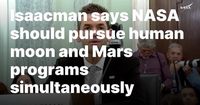COLORADO SPRINGS — Jared Isaacman, the White House’s nominee to lead NASA, made a strong case during his confirmation hearing on April 9, 2025, advocating for a dual approach to space exploration that includes both a human return to the moon and crewed missions to Mars. Isaacman’s comments came as he faced questions from the Senate Commerce Committee, where senators, particularly Sen. Ted Cruz (R-Texas), expressed concerns about the potential implications of shifting priorities at NASA, especially in light of competition with China in space exploration.
In his opening statement, Isaacman emphasized, “We must stay the course,” referencing the Artemis lunar exploration campaign. Cruz underscored the urgency of the matter, warning that an extreme shift in focus could lead to a “red moon,” allowing China to establish a foothold in lunar exploration for generations. “What will 2030 look like?” Cruz posed, displaying a stark poster contrasting American astronauts on the moon against their Chinese counterparts.
Isaacman, however, remained firm in his belief that NASA could effectively pursue both goals simultaneously. “We don’t have to make a binary decision of moon versus Mars,” he stated. “We could be paralleling these efforts and doing the near-impossible.” He asserted that returning humans to the moon is a priority and committed to doing so before China’s anticipated return by 2030.
During the two-and-a-half-hour hearing, Isaacman reiterated his support for the major elements of the Artemis program, including the Space Launch System (SLS), Orion spacecraft, and lunar Gateway. He acknowledged the complexities of balancing the Artemis program with ambitions for Mars exploration but expressed confidence that NASA could manage both within the current budget constraints.
“I think we can absolutely do that,” Isaacman told the senators, referencing NASA’s historical achievements, including the rapid progression from Alan Shepard’s suborbital flight to the Apollo moon landing in just eight years. He insisted that the agency’s capabilities are strong enough to handle concurrent missions to the moon and Mars.
Isaacman also addressed the ongoing operations of the International Space Station (ISS), committing to its continued use until its planned retirement in 2030. This stance contrasts sharply with comments made by Elon Musk, CEO of SpaceX, who suggested that the ISS should be deorbited as soon as possible. Isaacman stated, “I do not believe we should deorbit it now. I think we need to make the most use of the space station while we have it.”
Despite his connections to SpaceX, which include commanding two private astronaut missions, Isaacman assured the committee that he had not discussed NASA-related matters with Musk since his nomination. “My loyalty is to this nation, the space agency and their world-changing mission,” he emphasized, aiming to quell any concerns regarding potential conflicts of interest.
Industry endorsements for Isaacman’s nomination have been strong, with a letter signed by executives from various space companies highlighting his unique position to bridge NASA and the commercial space sector. Peter Beck, CEO of Rocket Lab, praised Isaacman’s commercial acumen and passion for space, while Kristin Houston from L3Harris Technologies stressed the urgency of having permanent leadership at NASA.
Janet Petro, the acting NASA administrator, expressed her eagerness for Isaacman’s confirmation, noting that the agency has been in a holding pattern without a confirmed leader. “Once we have an administrator and we get our budget from the White House, we can start looking at any changes in priorities,” Petro stated.
Isaacman’s journey to this point is notable; he dropped out of high school at 16 to create Shift4 Payments, a company that has since processed payments for over 200,000 businesses. His experiences as a successful entrepreneur and private astronaut have positioned him as a key figure in the evolving landscape of space exploration.
As the hearing proceeded, the presence of the Artemis II crew, scheduled to fly around the moon next year, underscored the urgency of the mission. Isaacman expressed his desire to see this crew succeed, stating, “We’ve got to get this crew around the moon and the follow-on crew to land on the moon.”
Concerns about funding and the future of NASA’s Artemis program loomed large during the hearing. The program has faced significant delays and budget overruns, raising questions about its viability under the current administration. Isaacman acknowledged these challenges but remained committed to ensuring that NASA fulfills its lunar and Martian ambitions.
“We will prioritize sending American astronauts to Mars, and along the way, we will inevitably have the capabilities to return to the moon,” Isaacman stated in his written testimony. This dual focus reflects a broader strategy to maintain U.S. leadership in space exploration amidst growing competition.
As the Senate Commerce Committee prepares to vote on Isaacman’s nomination, the outcome remains uncertain. However, his vision for NASA—one that embraces both lunar and Martian exploration—has the potential to redefine the agency’s trajectory in the coming years. With the world watching, Isaacman’s leadership could mark a pivotal moment in the quest for space exploration.





